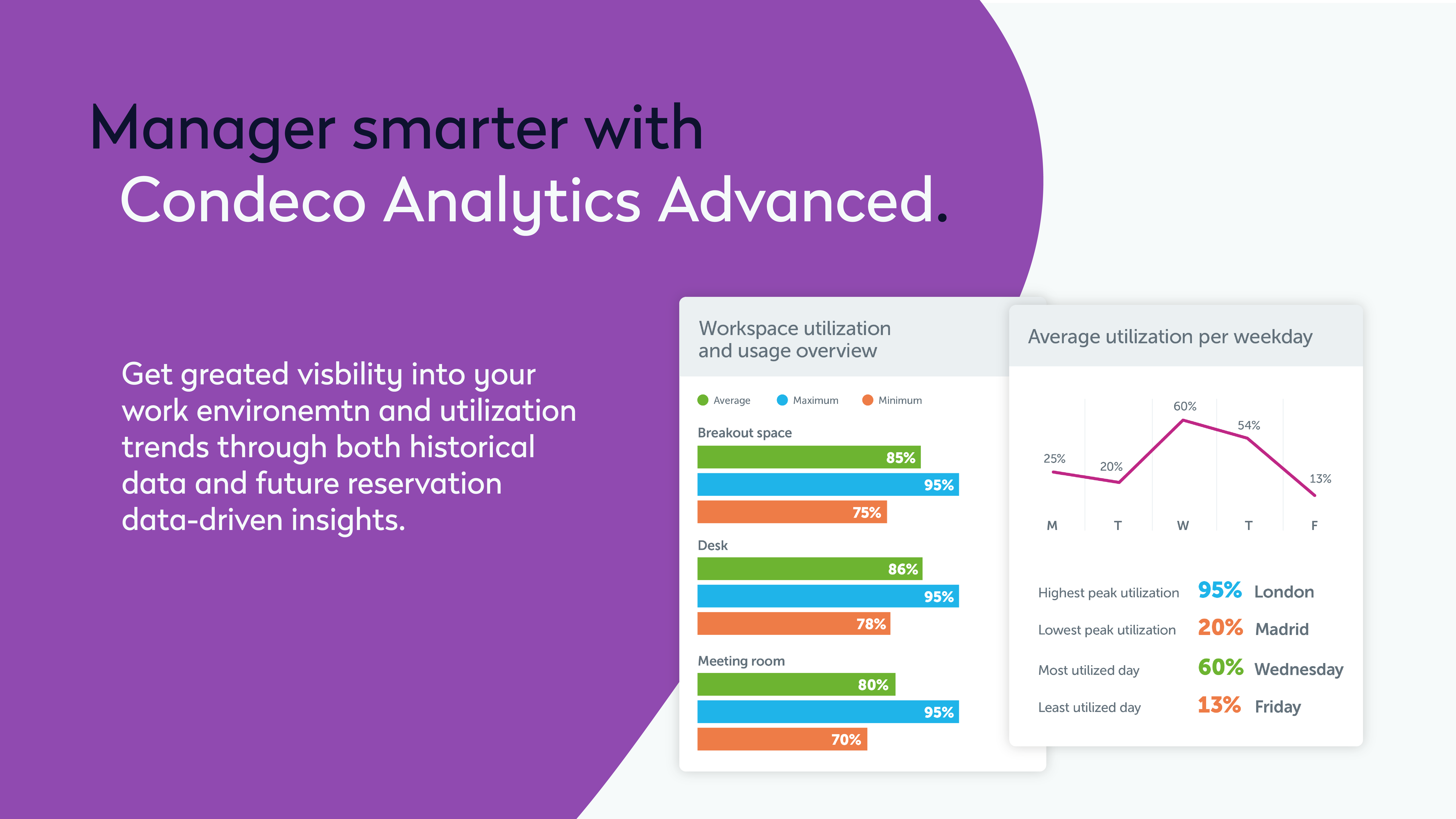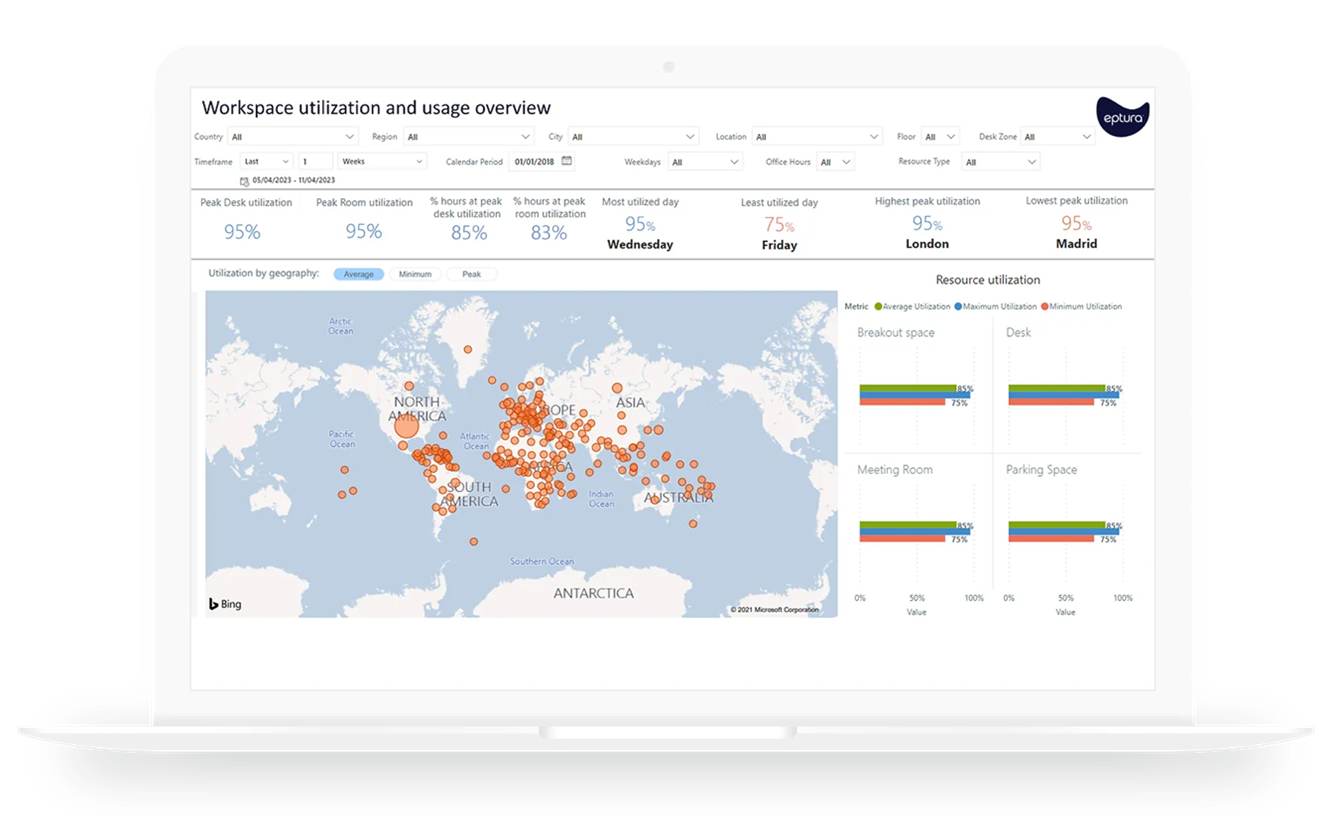
Managing today’s workplace and all the space within it feels more like an art than a science. Well, we’re here to show you that managing workspaces effectively can be a reliable, repeatable experience where facts, metrics, and patterns drive future planning and alignment with business objectives.
Consider today’s demands: Employees have been adapting to rapidly changing hybrid work models and are now accustomed to flexibility. So have you, facility manager. You’ve learned to adapt quickly and creatively to the space needs of the business.
It isn’t always easy to meet the needs for business growth and the employee experience simultaneously. Every department in your organization has different workspace requirements and preferences. Your sales team has very different daily responsibilities than your finance and human resources departments. So, your office neighborhoods and zones need to meet their specific needs.
People aren’t coming into the office on the same days of the week anymore, but you still need to ensure there are desk and meeting rooms for everyone.
There are clear ways to learn how our workspaces are being used by looking at the data. And as more and more workplaces have embraced digital transformation, there are more data sources to help you make decisions than ever before.
Remember, as a business, the long-term goal is to increase sales and profits – and to improve customer satisfaction and manage operational efficiency effectively.
When you’re able to regularly and easily analyze data, it will become an ingrained part of facility management. Valuable insights will lead to improved, proactive planning. Stakeholders will agree to office redesigns and space optimization faster and with more support because everyone will see and use the same transparent information.
Need a better way of mitigating risks in business? Want to better understand customer behavior and customer journeys? Good data can help you. Here’s how.
How data analysis helps solve business problems
In an era of rapid rightsizing, your meeting rooms, desks, quiet areas, large collaborative spaces, even your cafes and break rooms, need utilization metrics to distinguish facts on the ground from underutilized building space. After talent, global real estate is the largest expenditure in organizations, so any costs you can cut here add up quickly.
One of the problems more precise workspace data can help solve for is the midweek mountain. Employees prefer to be in the office on Tuesdays, Wednesdays, and Thursdays – with 88% of people working from home on Fridays. If most of your workforce is working at home twice a week, for example, that leaves a lot of desks empty – at a cost of $3,600 (£2962) per employee a day, according to Condeco by Eptura estimates.
Without a schedule, there’s no way to effectively plan necessary building and maintenance services, such as catering and cleaning, and it’s also impossible to support effective collaboration between teams. Based on our data, the cost of 10 unused workstations equates to $77,850 in unused resources.
Plus, you’re paying to keep the lights on, for the plumbing to work, and keeping a facility crew available every day. In today’s business climate where fluctuating energy prices and sustainability are top of mind for company boards and shareholders, someone’s going to notice those electricity and HVAC costs.
Data analytics allows everyone to see patterns of behavior over time represented in statistics. The most important decisions cannot be made by gut feeling or instinct alone anymore. You need more than just the subjective, “artistic” elements in both the decision-making and the decision-justifying processes. Numbers are your new best friends.
“Data analytics does not mean that the intuition of leaders and managers should be ignored or is unimportant, but it does provide an invaluable way to check it and, if the two views do not triangulate, to ask searching questions about which view is right,” reflects Graham Harrison, data scientist, in the Toward Data Science post “The Value of Data Analytics to Leaders and Managers.”
Wondering what kind of data analytics can help you most?
Leveraging data: What are the valuable insights data that can help me with in facility management?
It starts with data collection.
Our sister platform, SpaceIQ by Eptura, gives a quick, high-level overview of what you need in the post “Facilities Management Data You Should Be Collecting”:
- Descriptive: Highlights a particular trend
- Diagnostic: Sheds light on the drivers of a trend
- Predictive: Forecasts new trends
- Prescriptive: Influences new trends
But let’s break this down with a little more detail:
Descriptive analytics
As iOffice by Eptura explains, FMs use descriptive analytics every day by collecting raw data and organizing it into actionable insights. Descriptive analytics answers the question “What happened?” and “allows facilities leaders to make short-term and long-term operational decisions based on historical data.”
Diagnostic analytics
The next logical step after understanding what happened is to dive deeper into patterns to better understand why. Think of it like a medical diagnosis after getting an X-ray.
Diagnostic analysis is used to isolate anomalies and trends to measure a strategy or initiative and to help improve your FM program’s operations and asset management – and can help influence budgetary decisions.
Predictive analytics
There’s no predictive analysis without first having the raw data collection and initial insights you draw from them. But it goes a step further by allowing FMs to see patterns for predicting future outcomes and situations. You can use predictive analytics to inform the basis for equipment upgrades, office and floorplan redesigns, and pinpoint when you may need new workspaces altogether.
“Predictive analytics also utilizes algorithms, machine learning, and modeling to help the FM team see patterns and relationships among different datasets to identify potential risks and opportunities,” finds iOffice by Eptura.
Prescriptive analytics
“Each subset provides insight into a different area of facilities management,” finds SpaceIQ. “For example, descriptive analytics can tell you that eight of your 16 hot desks are currently occupied, while predictive analytics tell you this number will be 14 of 16 tomorrow based on past trends. How you use this data depends on your goals.”
Condeco Analytics Advanced is here to help you grow your business
With Condeco Analytics Advanced, you get greater visibility into work environments and utilization trends. See exactly how office space is being used today. Goodbye, guesswork. Make data-driven decisions faster and with more accuracy.

No more tiny columns and rows of numbers in a spreadsheet. Time for rich dashboards using data in context directly within the workplace scheduling system you already use. Say yes to dynamic data.
You can now:
- Gain in-platform workplace intelligence, eliminating the need to export and manipulate data in third-party tools
- Uncover multiple dimensions of data to understand strategic and more granular drivers of workplace utilization and occupancy across all resources and locations
- Customize views by timeframe, office location, resource type, floors and office hours to measure behaviors
- Produce data-driven insights into historical resource usage and harness top-tier analytics capabilities to plan for future space needs
- Create custom bookmarks to save filtered views of specific workplace information and share these key insights with relevant stakeholders
- Refresh data in real-time to get the most recent insights and leverage accompanying Power BI templates to further analyze data offline

Go beyond the headlines and anecdotal feedback and deliver data-driven insights around workplace resource usage, employee engagement, and long-term demand trends.
Learn more about our Workspace Management software.



